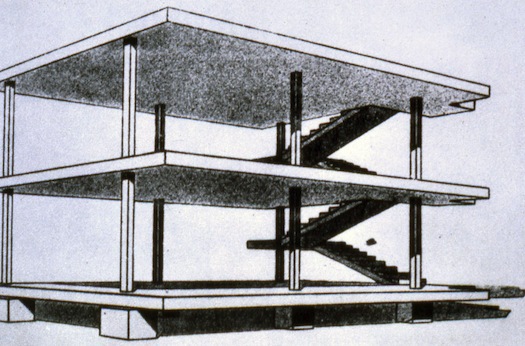
Le Corbusier, skeleton for Domino House, 1914–15
As we innovate on methods of service delivery at the Taproot Foundation, my colleagues and I frequently find ourselves grappling with the question of how to scale an organization so it is optimized for impact. As we explore ways in which other types of enterprises have dealt with this kind of growth challenge, it is tempting to remain fixated on an analysis of traditional organizational models — functional, divisional and matrix — in the quest to find one we could adopt.
Such organizational models emerged in the early part of the 20th century to prevent chaos and to promote efficiency in growing businesses. Unfortunately, management theory today confirms that these very structures can become so rigid that they often prevent creativity even as they preserve order.
This all got me thinking: how much structure does a small organization really need? In mulling over this question, I found myself thinking about the work of the famous Swiss architect Le Corbusier (1887–1965) and his distinctive plan libre.
During the early days of Le Corbusier's career, buildings were designed to reflect traditional bearing wall construction, which often limited the placement of interior walls. But LeCorbusier changed all that with his most iconic design and lasting legacy to the architecture profession: the Domino house. Conceived in the 1910s, it promoted a simple grid of structural columns supporting horizontal concrete slabs. This organizing armature allowed for a more important innovation to be realized: a "free plan" of undulating walls that could be placed in a variety of configurations to achieve spatial ingenuity. This was achievable because the walls were not limited by the structural grid, but rather enabled by it; as Corbusier noted in Towards a New Architecture, the grid became "the function that gives the form to the interior space."
To bring the conversation back to that other kind of structure — can we design nonprofits for efficiency as well as creativity? Can there be just enough structure in the right places to not only support, but also enable the kinds of human interactions that will help them operate as creative entities? In an ever-changing world, organizations of all kinds must be both strategically adaptable as well as operationally efficient. In the words of management guru Gary Hamel, writing in The Future of Management, we must "build organizations where discipline and freedom aren't mutually exclusive."
Organizations that enable some freedom of activity are naturally structured for creativity. They are often characterized less by prescribed roles, functions or departments and more by the types of human interactions their culture desires. Typically these are reflected in such things as a strong sense of community, interdisciplinary collaborations, a "one-team" mentality, and an open environment (both literally and figuratively).
When thinking about what kind of structure is the right kind of structure, we need to ask ourselves what kinds of behaviors we are trying to encourage so that our relationships — both internally and externally — deliver unique value and have real impact. Too much structure can mean too little freedom to explore and adapt. That’s something we need to prevent from happening.
